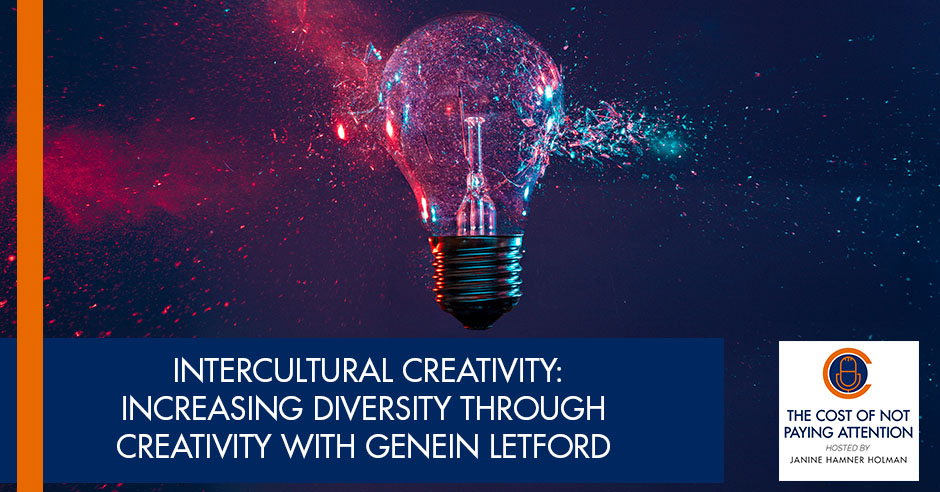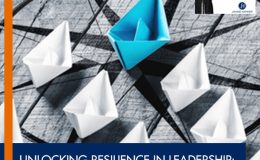
People don’t unleash their potential to be creative because, from childhood to being an employee in the workforce, there are external factors that contribute to losing their confidence…but our ideas matter! Listen to Genein Letford as she dives deep into her unique perspective about developing critical cognitive tools for creative thinking. Genein is a national thought leader and creator of the concept of Intercultural Creativity. She is the Founder and Chief Creative Officer of CAFFE Strategies LLC, a consulting, coaching, and training company that trains C-Suite executives and employees to create sustainable organizational equity and inclusion strategies while unleashing their innovative thinking for themselves and in their businesses. In this episode, she joins Janine Hamner Holman to discuss human development and opportunities to increase diversity through creativity. She emphasizes that we aren’t paying attention to how our cultural lenses and experiences shape our lives.
HOST: Janine Hamner Holman | Janine@JandJCG.com | LinkedIn, Facebook, and Twitter | Subscribe to my Newsletter! Book me to Speak!
—
Listen to the podcast here:
Intercultural Creativity: Increasing Diversity Through Creativity With Genein Letford
A Conversation With Genein Letford
What am I paying attention to? I saw this statistic that took my breath away. The statistic was that 97% of Black employees do not want to return to an office environment. I have no idea if this statistic is 100% right or not but what it’s pointing to is that a lot of Black people in particular, and I would suspect people of color in general, would prefer to not be in an office because of the shenanigans that are going on in offices. As we are continuing in our conversation around diversity, equity, and inclusion, this felt to me like an important indicator.
That bring us directly into our conversation with Genein Letford. Genein is a global speaker and a trainer on Intercultural Creativity. As the 2019 LA Lakers Business Woman of the Year, she empowers organizations to connect, create, and innovate across cultural lines. She is the Founder and Chief Creative Officer of CAFFE Strategies LLC, which is a consulting, coaching, and training company that trains C-Suite executives and employees to create sustainable organizational equity and inclusion strategies while unleashing their innovative thinking for themselves and their businesses.
She published her first children’s book called I AM CREATIVE! with her son, Shawn Letford. Genein believes creative thinking thrives best in an inclusive environment. She is often called America’s Creative Coach for her work in reigniting Intercultural Creativity within our workforce.
—
Welcome, Genein.
It’s so wonderful to be here, Janine.
I’m so excited to have this conversation with you. You and I both love getting to play in the arena around diversity, equity, and inclusion. My prediction is that there are going to be places where we see things exactly the same way as well as places where we see things from different perspectives. I’m excited to get to explore all of that with you.
So am I.
Let’s start how we start, which is: what is something that you have become aware of that people are not paying attention to, either intentionally or unintentionally? What’s the cost of that?
Awareness is key. My background is in Psychology Education and I say I have a street degree in Neuroscience. I don’t actually have a degree but I have been in the world of neuroscience for many years, and I’m seeing the implementation within the business world. What we are not paying attention to is the fact of how our cultural lenses and cultural experiences, and this can be attached to the stat you shared at the beginning of the show, affect our creative thinking and how important creative thinking is not only to the mental health of the individual, but it’s also important to the health of the organization.
Awareness is key and cultural competence is the ability to adapt. Share on XWe are not paying attention to what affects creativity and how we can develop it within our people. There are billions of dollars that we are losing because people are not operating at their highest creative potential. They don’t even want to go back into the office, so you know for sure they are not operating at their transcendent level of creative thinking.
One of the things that I love getting to talk about in the conversation around diversity, equity, and inclusion is when organizations are more diverse, they are more creative. When we have different opinions and life experiences around a table, whether it’s literal or virtual, we get better ideas, are more creative, and springboard more off of each other. This idea around intercultural sensitivity and how that connects with creativity is a brilliant way into the conversation. How did you come up with that?
I must admit that it was a divine a-ha moment like Eureka! My background is in education, so I have been teaching cultural competence and integrating it within the curriculum. I had students who thought every Asian person was from China and I’m like, “That is not true.” When I say cultural, I don’t just mean ethnicity, culture, or nationality. A culture is a group of people with verified values, beliefs, and systems that they have agreed upon. You can have a soccer mom culture or tech culture.
I was doing that work with children for a while and children, as the research shows, are at their creative genius before they get culturized into a system of conformity. That is what the book that my son and I came out with is about. It’s looking at the innate creative traits that we have. I realized I could train adults to get these creative thinking and cognitive thinking traits to be in their optimal position.
Creativity is all about presenting the new. If you’re in an organization where you cannot speak up, there are microaggressions going on, the culture is hung on the status quo, and you can’t challenge authority. There are so many invisible blockers to creativity that needs to thrive that we are not even paying attention to and it cost us billions.
This phrase that you have, that I know you have trademarked, is Intercultural Creativity. Dive into that a little bit more, will you please, with our readers around what you do working with either individuals or organizations or when you’re doing your keynote speaking. What are you pointing to? What are the takeaways that you love when people receive?
It’s a benefit that I started my career in Elementary Ed because I have the gift of breaking things down. Albert Einstein has said, “If you can’t explain it to a six-year-old, you don’t know it yourself.” I love that because it’s true. One of the elements of creativity is being able to abstract the right information and make sure things are simple. I do that as well. Malcolm Gladwell is great at that. He writes everything at an eighth-grade level so people can get it, but his ideas are still huge. Everyone has access to his ideas. They are not esoteric language.

Intercultural Creativity: Creative thinking is important not only to the mental health of the individual but also to the health of the organization.
What I do with organizations in my keynote speaking is first, clarify what things are. A lot of people are working with different definitions of creativity. Thirty percent of people think it’s the art. They are walking around saying, “I’m not creative.” Other people are dealing with something I’m terming creative abuse, meaning they had a statement said to them in tenth grade, so they don’t open their mouth in public or do artistic creativity at all because they got shot down in high school. Sometimes, I meet a lot of adults bringing that into the workforce.
In grade school, kids get shamed early around like, “I made this picture of a horse and somebody thinks it’s a cloud. I decide that I can’t draw.”
It’s artistic creativity. We tell our kids, “Color the sky blue, color the grass green, or color the clouds white,” even though I have a picture of my son looking at pink clouds because it depends on the time of the day. At sunset, the sky is purple. We are training him to be at odds with what they’re sensing. When they’re adults, they don’t trust their senses and ability to bring in data.
That is one thing. The main thing that I do after clarifying these terms of what creativity is in my company is the process of problem-finding and problem-solving with relevance, value, and novelty. That’s what I believe, which includes artistic creativity as well. Creativity is the process of problem-finding, meaning highly creative people don’t wait for managers to give them problems. They’re out there being curious and asking questions, “Why is it that way? Why don’t we do it this way?” They’re doing that on their own and not being forced to.
That’s brilliant.
Brilliant is a good word. The brilliance of that wonderful way that we are representing this term is we divide the 7 Gems of Intercultural Creativity. My logo is a diamond. I don’t use it for metaphorical reasons. If you’re a teacher, you can teach a ton of lessons with the diamond. We’re multifaceted. The original story of heat and pressure.
I also want people to understand that number one, we are multifaceted. There are so many lenses that color how we see the world. You can be surrounded by diamonds that could be in their original form and not even know it. That is what’s happening a lot. There are these amazing people in our workforce that have these great ideas that they’re unable to bring to the surface because they’re not in an environment that supports them. With the Seven Gems of Intercultural Creativity, we can go through them back and forth.
The first gem is the creative growth mindset. You always have to start with mindset. I know you do and you’re big on this as well in your work. You can’t get any external results without the internal workforce. Based on the work of Carol Dweck with growth mindset and fixed mindset, you have to first believe that you can grow in your creative thinking and cultural competence.
The term Intercultural Creativity is a combination of cultural competence, which is your ability to interact with different cultures and be aware, awareness is key to cultural competence and adaptive behavior. In this gem, I go over the fact that these two areas, creativity and cultural competence, are developmental, which means you can get better, like Trigonometry. When you practice Trigonometry, you can get better. Trust me. No one gives five-year-old Trigonometry because developmentally, they’re not there yet but you’re never going to say to the five-year-old, “You will never do Trig.”
You know that there are things that have to happen first. In cultural competence, people can work on this. The formative years are very important depending on what they were exposed to. Some people come in your organization at a higher level of cultural competence than others, primarily because of those formative years and exposure. That is the first gem.
I love honoring where people are and understanding that there may yet be more steps to come. I was looking at something recently that was talking about self-awareness. Most people think, “I am self-aware.” Statistically however, somewhere between 10% and 20% of the population are self-aware. There’s this great opportunity to remember that we are all works in progress. We don’t have to be held hostage by our upbringing, parents, cultural sensitivity, or lack thereof. Whatever it was, was whatever it was. We have an opportunity to move forward.
There will be places where we see things exactly the same way and places where we see things from different perspectives. Share on XIt helps with an offense. If someone says something offensive, I’m like, “This person may not have had the self-awareness, time, training, and exposure. They are over here on the continuum.” There’s a great continuum that your readers can look up called the Intercultural Development Continuum by the work of IDI or the Intercultural Development Inventory. It’s an assessment that my organization can give so people can see where they are on the continuum with that. That is a huge one. I have great stories to back that up.
Your next gem is called the Empathetic Way. It goes into the importance of empathy. In order to grow your creativity, you have to have empathy. The same is true for cultural competence. They say the number one indicator of a highly creative person is openness to experience. The number one indicator of a highly interculturally competent person is openness to people with different lived experiences.
If you’re closing yourself off from anyone who is unlike you, not only is that wrong, but you’re also limiting your creativity and shooting yourself in the foot when you think about it. In working on the skills of empathy, there’s a lot of neuroscience behind that. There’s a lot of training that my corporation does on how do you build empathy within people to continue that journey of Intercultural Creativity.
There was a meme that I have seen of Samuel L. Jackson pointing and saying, “Be empathetic, MotherFer.” I love that because there has been so much in our world around empathy. It’s something that a lot of people are now hearing about in a way that we weren’t hearing about years ago. If you don’t know what empathy is, aren’t in an organization or program, or don’t have access to that learning and understanding, it’s like, “I’m supposed to be this thing called empathetic but I’m not sure what that is or how I go about doing that.”
I just finished listening to Chelsea Handler. She has a book called Life Will Be the Death of Me:…and You Too!. As per Chelsea handler, it is both very funny and quite irreverent and has many naughty words in it. As my readers know, my policy around swearing is I’m a grownup. Sometimes, that means that I swear. I will never swear for impact, like, “Ooohhhhhhh, she said a bad word,” but I will swear for accuracy. Because, if it’s fucking bad, it’s fucking bad.
The world that we’re living in around empathy, this curiosity that you’re pointing to, and being interested in people who are different from us and have different lived experiences from us is so important. We are in this place of such polarization and it’s leading to people being in thought bubbles and community bubbles of people who are like ourselves.
We have confirmation bias, affinity bias, and all of these unconscious biases that lend us to want to be in those kinds of communities. When we have such vitriol on all sides of the spectrum, it can make it more challenging for people to want to step outside their comfort zone. But when we step outside our comfort zones and challenge ourselves to listen and get present to the experiences of people who have different life experiences from us, it not only expands our perspective but it also has us being more creative.
Sometimes, people need step-by-step hand-holding and action items. As you said, the terms like, “Be more empathetic,” can be abstract. People don’t know how to walk that out. That’s what we do. We look at how do you walk this out day-by-day. What does empathy look like in a meeting? What does it look like at home with your family? There are different contexts that ascribe to different behaviors with the same underlying goal to make those connections there. That’s gem number two.
What is the number three?
You might like this one. This is cultural observation. When we think of the term observation, we normally think of, “What are you observing and seeing?” The term observation, to observe, comes from Latin and it means to attend to. What are you paying attention to? Number one, you can first look at the physical senses. We are already at a deficit. There are sounds we can’t hear that dogs can hear. There are things we can’t see, like microwaves, gamma waves, and radio waves.
What we can sense with our physical senses is very tiny. With technology and phones in front of our faces, we are missing even more and not paying attention. This is why this show is so on point and ready for this time because we are not, as humans, paying attention. You saw the pandemic and it woke a lot of people up. They were like, “What’s going on?” It’s because we weren’t paying attention.
My book is coming out, the 7 Gems of Cultural Creativity. In this chapter, I first go over what does it mean to have observational complexity. I use the story of my sister and I going wine-tasting and how there are two types of wines to me, which are red and white. My sister, who’s an avid wine taster, is like, “Look at the reds. There are all these varieties.” Her vocabulary and observational complexity are far more advanced than mine. Once again, red and white, that is as far as I know.

Intercultural Creativity: There are so many blockers that creativity needs to thrive, and we’re not even paying attention to it. It’s costing us billions.
It’s a funny story when you’re talking about wines but it can be a detrimental effect when you’re talking about people, relationships, and organizations. We’re not paying attention. There are people, and I’m pretty sure you’ve met them, that is very advanced in detecting the emotional climate. They know how to connect well with people, hear the words that aren’t being said and see energies. Their observational complexity is very high, emotionally or physically, and their physical senses.
Once again, I’m an educator and developmentalist. You can train this. You can’t say, “I want to be more observant,” and then stop there. There are things that you could do. We look at cultural creativity because you have to be observant to be very creative and then transfer that to cultural observation. How do you observe the people you work with, look at their multiple facets, and see them as the multifaceted diamonds that they are?
I love that last thing that you said, “How do we see them for the multifaceted diamonds that they are?” Often, we see the container that somebody is in, which is all of these bodies that we are in. They are containers for our soul, brain, and essence, which is what we care about and want to get to know in another person. What we judge each other on, though, is the container. I have lived my life inside of a body that is not as thin as the world would like it to be and I have struggled… and been made to struggle.
Kids and adults say things that are not nice and we say things to ourselves in our minds that are worse than most things that anybody else would say to us. As I have been working on my unconscious biases, I realized several years ago that, because I have struggled with my weight my whole life, I have a previously unconscious bias against women who are naturally thin. I would make up this whole story in my brain and it would happen in an instant, which is how unconscious bias works.
It’s not us. It’s a function of our brain. It’s something that triggers in our brain. My brain makes up this whole story about who this person is based on their container. One of my favorite things is when I make or my brain makes that snap judgment, I realized through experience, like, “You’re not at all who I decided that you were in that one millisecond that my brain made a decision about you.”
Now that I know that about myself, I can then make a conscious choice about how I act into that or not. One of the keys with getting to see people as multifaceted is understanding that, because of neuroscience, how we are wired, and the amount of information that our brain is trying to make sense of so quickly, our brain sorts people into piles, but we have a choice to move them out of that pile and get to know the multifaceted diamonds that they are.
If you work at this long enough where it gets a part of your subconscious, your brain will stop sorting. My philanthropic arm is to assist with the plight of homelessness. I have trained my brain. We are in a culture that if someone is on the street, your brain automatically categorizes them and may have attached all these stories. One of the things that happened that I do that has worked well, going back to my diamond metaphor, is that the pupils are powerful. Those are the windows into the soul. I’m like, “What diamonds are they carrying within in them?” We’ve all had life issues, bad choices, and good choices.
For a lot of people who may be experiencing home homelessness, life hit them hard. It’s a series of bad luck things and not because of any drug issue or whatever. There are people with food insecurities and other things that you and I may not be thinking about on a daily basis. I’m reminding myself that everyone has diamonds and creative potential within them. We just are in different places and hopefully, we will be able to get back up.
What is our next diamond?
Your next one is we have to create that mindset the empathetic way, observational complexity, and then cultural curiosity. When I do my keynotes, I always go, “Curious George, the curious little monkey.” Everyone knows Curious George and I always say, “Who knew this little monkey that got into everything and annoyed The Man with the Yellow Hat has one of the top traits that CEOs and C-Suites need in order to make sure their companies not just thrive but also survive?”
I interviewed on my show, Create and Grow Rich podcast, Dr. Alison Horstmeyer, who has her Doctorate in Workplace Curiosity. Who gets their Doctorate in Curiosity? That is fascinating. You might want to reach out. She is great. She has all the research and studies studying the curiosity levels. Who woke up this morning and said, “I’m going to do fifteen minutes of curiosity training?”
We lose billions when people don’t reach their potential in creative thinking. Share on XAs I said before, a lot of it is because of the formative years. Some people with their formative years had a culture that supported the curious level of their development. A lot of people, the second they start asking questions, they get shut down. You deal with that over and over again through the years, so now you have people in the workforce who don’t ask questions and are not curious.
I get triggered when somebody says something that I have a hard time being with, where I try to go is to curiosity. It’s the easiest place for me to go to still have an opening for a conversation. I love that diamond.
I do talk about the importance of being curious respectfully, avoiding microaggressions, and, “Can I touch and grab your hair?”
It’s all the things that we do or might be tempted to do. I love babies. If I see a pregnant woman, what I want to do is touch her baby bump but I don’t know her. I have no right to touch her and certainly not to touch her stomach. Talk about something that is private. We have this instinct. It’s checking that and remembering like, “This is a part of another human. We don’t get to go up and touch them without permission.” Even asking permission like, “Can I touch your hair?” That is a weird-ass question to ask any human.
If you think like, “That would be a weird question to ask,” it’s an indication, “Don’t do that.” In our world, “Are you a hugger?” That’s a question that I ask a lot because I am a hugger. I am very physical with my emotions, so I want to give you a hug. I also want to be respectful of who you are, so, “I am a hugger. Are you a hugger? No? We won’t hug. Am I a hugger? You’re a hugger. Bring it in.” I love that concept. Thank you.
Especially in these times when everyone is so solemn, that is that gem. The next gem is something called Perspective-Shifting or Perspective-Taking. I spoke with Dr. Michael Platt on my show as well. He is one of the top Neuroscientists in the nation out of the Wharton School of Business. He talked about how people who know how to perspective-shift and perspective take will be on the forefront because of your ability to make that connection and to get yourself in someone else’s shoes.
Dr. Daniel Siegal talks about the right way to perspective take where you’re not over-identifying with someone and going into a panic because of the things that they’re going to do, but you’re able to help prospective take in a healthy way. Once again, this is a developmental skill. What does that look like? How do we increase the perspective-taking abilities of our leaders and of everyone, but definitely of our leaders who have to lead these teams in a new way in this new era?
I love this idea and it’s not something that I had heard of before. Certainly, I’ve heard of perspective but perspective-taking gets me curious. How is that different from empathy?
Empathy is going to understand that you’re emotionally connected and your understanding of a person’s lived experience. In perspective-taking, in my mind, there’s a lot of neuroscience. It’s almost not just putting yourself in their shoes, but it’s your forethought or you’re going into the past. You’re always looking at the whole storyline and using your imagination a lot more.
They said that in perspective-taking, neuroscience shows that the part of your brain that is in-charge of your innovation network, imagination, wondering, and where new ideas come from, which is why rest is so important. It is so that your imagination network can turn on. That is the same part of the brain that turns on when you’re taking the perspective of another person. They are closely aligned. You have to be empathetic in order to perspective take well but prospective take taking, I believe, can go on into some deeper steps.
I love learning about new things. What is our next diamond?
Your next one is authentic adaptation. When people are empathetic, have open minds, are observant and curious, and know how to perspective shift and perspective take, you’re now able to adjust your behavior according to cultural situations. Do you know those friends you have that no matter what area you’re in, they’re able to make connections with the people and make people feel accepted and at home? They have all those gems in place and they’re able to adapt their behavior authentically.
I put the word authentic there because you have done your work and know core values. You’re not adapting your behaviors that are going to violate who you are, what you believe in and your core values. You might have some difference in thinking like, “I never saw it that way.” My core value is to treat people with respect. That’s a core value. I’m not going to shift into a culture where I start demeaning people to fit in.
In adaptation, there’s a TEDx by Dr. Shimi Kang. She talked about her psychological studies with her clients. The number one trait that took the group who was going and advancing in the right direction was adaptation. It’s these people who have had to adapt to different life situations. What does adaptation training look like? How do you do it in different scenarios at work and at home?

Intercultural Creativity: One of the elements of creativity is being able to abstract the right information and to make sure things are simple.
That is the last big gem because the final gem, I did say seven gems, is a conglomerate of them all. They are working all together. You never finish a gem. You’re always refining until your last day on the Earth. The last gem, I call it being a bridge. It’s like the work of Malcolm Gladwell. I’m a huge amount Malcolm Gladwell fan. He talks about in The Tipping Point the power of the connector. It’s that person who knows how to connect different cultures. They’re not just adapting, perspective-taking, and connecting with people. They know how to connect different cultural groups together. They are the bridges. You want bridges on your team.
Going back to the work of Daniel Siegal, he says an integrated brain is a healthy brain. If you can integrate your relationships, acknowledge differences but still link them together, that is a healthy brain. People who know how to do that within their brain and relationships with people and the Earth, or how do you respect the Earth and adapt when the Earth is doing what it’s doing because we’re not treating it too well, that is the royal gem. The gem that we want to get to as we keep refining the other gems is being a bridge and creating across cultures.
There’s so much in here. The concept of emotional intelligence started as a personal development tool and then organizations realized, “This has a huge impact for the business. We want to bring these tools into the workplace and work on emotional intelligence inside the context of our business, company, and organization.” I can see that there would be ways for both individuals and organizations to decide, “I love what Genein is talking about. I want to get on this path of developing my diamonds.” Is this something that I can do as an individual or something that you’re doing with organizations, or both?
It’s both. The book is coming out soon. I didn’t know editing would take so long. You can be exposed to the concept because you are shifting beliefs. Anytime you’re dealing with belief systems, Frederick Douglass says, “It’s easier to train up a child than to repair broken men and women.” A lot of repairing, dismantling, and then rebuilding belief systems are going to have to happen for this next era and future of work. There will be a lot of classes coming on and we are going even to have an Intercultural Creativity certification.
How do I replicate Genein? I do have a twin out there. How do I have a lot of twins out there who can teach this? Once again, people who understand how children develop and learn are a step ahead because it’s all human development. We get red flags when children don’t hit their milestones. If you meet a five-year-old and five years later, she hasn’t developed at all cognitively or emotionally, that’s a red flag. You would start asking for services, get tests done, and do something. If you had a 30-year-old, meet him at 35, and no changes happen, why doesn’t that give us red flags as well?
I was talking with a woman who has many degrees. I grew up in Cambridge, Massachusetts. She went to Harvard and MIT and has all of these highfalutin degrees but feels very stuck in her life. One of the things that she and I were talking about is that all people, at one point or another, get stuck in something, in a place, or with an idea. There becomes something that we’re not paying attention to. We have the opportunity to bring that into our consciousness and then move forward and through it.
How many of us end up stuck at some place in some time and don’t have the opportunity to move through it? This brings me to this thing that I wasn’t thinking before that we would talk about. I’m curious about your perspective on this. You and I both get to play in the big ocean called diversity, equity, and inclusion. We get to swim in this ocean and it is an ocean that has gotten a lot of feelings attached to it.
I’ve been doing a webinar that has been getting a lot of very positive attention around diversity, equity, and inclusion and how we need to flip it and start with inclusion. What we’ve been doing as a culture is starting with diversity and saying to HR, “Go get us some of those people who are different from whoever it is that we are.” Those people come, look around, and say, “There’s nobody like me here. You are all icky to be with, so I’m out of here.”
The people who were there in the beginning say, “This diversity stuff is stupid and we’re not going to do that anymore,” which is why 90% of the diversity efforts that organizations have undertaken over the years have failed. My perspective is we need to start with inclusion. How would it be for me to be with you as something different from who you are?
Creativity is all about presenting the news. Share on XWe get to start with psychological safety. We get to start with a conversation about who do we want to be and why, from a business perspective, would it be great for us to be more inclusive? If we’re a nonprofit organization, how, from a mission perspective, would it be great for us to have differing perspectives at the table. In many people, I don’t know if it’s that they got freaked out by words like privilege or think that somehow there’s a zero-sum game, “If you have more power, that means I have less power,” which is not the way power works.
In this webinar, one of the things that I do is I have a word cloud. I was intentional in creating this word cloud so that some of the words are words like privilege, racist, and words that have a negative connotation around them. Some of the words are words like empowered, curious, and words that have a positive connotation. Some of them are neutral words like male, female, Black, White, gay, and straight.
When you put them into a word cloud and ask people to look at them, most people say that the word cloud makes them feel bad, challenged, ashamed, afraid, angry, and the list goes on. I’ve been asking people, “Take yourself off mute. Tell me some of the words that you feel looking at this word cloud.” The words are, by design, not all negative. About 1/3 of them are negative.
Part of where it’s taking me is in the world of neuroscience. Our brain gets triggered by negative words more than positive words because our brain is constantly concerned about, “Am I safe?” There’s other stuff in the ocean that we’re swimming in that has led people to feel negative, afraid, or, “This conversation is going to make me feel bad.”
One of the elements that help my training stand apart is I’m entering through the door of creativity. There is less threat threatening. When you say words that are negative, you have to be very mindful that something that may be negative to you may not be to me and vice versa. Even terms like Black, White, straight, gay, or whatever, you have no idea what cultural experiences or cultural lenses people are interacting with every single word. The word money should be a nebulous term. There’s no negative.
It should be a neutral word but so many people have so much stuff around money.
Behavioral finances is a field now because it’s very emotional. I go in with that awareness. Going back to attention and awareness, I had no clue how you interact with that. I use creative means. We have Lego Serious Play-certificated trainers on our team. We use Play-Doh and the arts. I’m big on the arts. I do say creativity isn’t solely artistry but artistry can greatly enhance your creative thinking skills. I’m a huge advocate for the arts. I don’t want people to think that artistry is the only thing.
I’m very mindful that people may be having a completely different experience with the cloud. That is why communication and vocabulary are key. I have a kid at home as the co-author of our book. They say, “To name it, you’re able to tame it.” It’s children mostly but you see the adults throwing a tantrum because they can’t communicate it well. They can’t describe it. Early on, we were going over those emojis with all the different emotions. I’m like, “This is frustration. Are you feeling frustrated? It’s when you’re,” and we go over that.
It’s cute with a two-year-old year old but I know 22-year-olds who still need that training. If you can name it, you can tame it and better interact with it. If you can do it within yourself, that increases your ability to do it with others. Look at the work of Daniel Siegal. The brain needs that internal work in order to do it externally.
That feels like a great place to end, except A) I don’t want to end yet because I’m having so much fun in this conversation, and B) I want to at least touch on the brilliant Shawn and your book I AM CREATIVE!. Let’s talk for a second about that.
My first mini-book is called the 16 Diamond Tools of Creative Thinking. I go over tools that you wouldn’t normally think of that are involved with creative thinking like belief systems, observation, a lot of the Seven Gems of Intercultural Creativity, but also abstracting, making connections, and pattern forming and recognition.
What people may not understand is having adults who have these skills is key. How do we not be parents, teachers, and caregivers that are accidentally squashing these skills in our kids without even knowing it? It’s from Shawn’s perspective. I say he’s my co-author because he wrote the book. He didn’t sit down and type it but he was doing the actions and asking the questions. I’m just putting it in English form. That’s all I’m doing. We are like ghostwriters.
Shawn is going through all of these diamond tools and I’m highlighting them for us. I’m also telling adults, “You could work on this too. You can pattern form and be observant of your surroundings. Smelling something, seeing it, putting it on your skin to feel it, you can do this too. You can make sure you’re not squashing it in your child as well, especially for the classroom culture.” That is key.

Intercultural Creativity: Intercultural creativity is a combination of cultural competence, which is your ability to interact with different cultures and be aware.
There are studies out there that go, “The team leader or the teacher’s view of someone has one of the highest effects on the creative potential of that person.” It’s the Pygmalion effect. They say out of all the leadership training, that was the number one aspect that they found consistent, “What is the leader’s view of the person? How do they communicate to them?” If they think they’re going to do well, you see them creatively expand.
If that boss or leader thinks that they’re not going to do well, their performance goes down in part. It’s back to the great work of Carol Dweck. It connects then to affinity bias and to confirmation bias. If you think you’re going to be awesome, you are much more likely to be awesome. If you think you’re going to be shit, you’re much more likely to be shit. How do we hold people as a possibility as opposed to holding people as a fixed entity where they are good at this and they are not good at that?
We have training around that too. It’s how do we open our viewpoint of people so they are able to bring other facets to work that can be the driving point and catalyst of the new ideas that our organizations are looking for.
Check out Genein’s book. This would be a great tool. I AM CREATIVE! has a wonderful cartoon of her son on the front. It’s not a photograph. It’s a drawing of a beautiful young man, a three-year-old. It also would be great as a grownup, whether you have children, like to foster the child within yourself, or realize reading this, “Maybe I’m not doing such a great job mustering the child within myself,” check it out. This has been wonderful.
If I could make one point with that, I do have a lot of adults buying this book just for them. It’s great.
I bet you.
Another point I want to make sure people understand was when I was at a hotel doing a keynote in Rhode Island, I saw two families. I was trying to give the book away to two White families. I was like, “I’m trying to give this away. I don’t want to fly home with it. Can I sign a book for you?” They were like, “You’re an author.” Their children are beautiful blue-eyed, blonde-haired children. It made me think, “I wonder if their library has any books where the main character is not White.”
You have to first believe that you can grow in your creative thinking and in your cultural competence. Share on XThe research shows that if you get cultural competence experiences around your children, they are more likely to be culturally competent in adulthood. It’s having books and people. People are the best thing to have a relationship. Books and people-positive media of different types of people doing well build their belief system. It was an honor to give these families a book of Shawn being curious, inventive, and creative.
There’s a book about snow that I grew up with as a child. It was one of my favorite books when I was little. The main character is a little Black boy. It was a little young man of color. I loved that book and I am 100% sure that when I was little, I didn’t notice that he happened to have more melatonin in him than I had in me. It’s one of the best things when we can expose children and ourselves to people who look different from us and have different life experiences from us. Our world is so much more enriched.
It shows them that everyone can shine bright in their special way. That is what we want ourselves and our kids to come to know.
The more our kids can believe it, then the more that is who is inheriting the Earth, the organizations, and all of the things that we are creating. Genein, I want to thank you so much for your time, especially for your wisdom, brilliance, diamonds, and all of the facets that are you. Thank you so much for being with us here and for sharing.
Thank you for having me. You are a gem.
As are you and as are you out there in our reading world. If you don’t feel like a gem, God knows there are days that I don’t feel like a gem. Underneath it all, we are all gems. We are all beautiful and brilliant in our ways. Thank you so much, Genein. Thank you to our readers for being with us. Remember, great leaders make great teams. Until next time.
Important Links:
- CAFFE Strategies LLC
- I AM CREATIVE!
- Life Will Be the Death of Me:…and You Too!
- 7 Gems of Cultural Creativity
- Create and Grow Rich
- Dr. Alison Horstmeyer – Previous episode on Create and Grow Rich Podcast
- Dr. Michael Platt – Previous episode on Create and Grow Rich Podcast
- TEDx Talk – What one skill = an awesome life?
- The Tipping Point
- 16 Diamond Tools of Creative Thinking
- Janine Hamner Holman – LinkedIn
- Genein Letford
- LinkedIn – Genein Letford
- Facebook – Genein Letford
- Twitter – Genein Letford, M.Ed
- YouTube – Genein Letford
- Instagram – Genein Letford
- I AM CREATIVE! – Amazon
- Janine@JandJCG.com
- Facebook – J&J Consulting Group
- Twitter – Janine Hamner
About Genein Letford
 As the 2019 LA Lakers Business Woman and the 2015 CA Charter Teacher of the Year, Genein is a national thought leader and creator of the concept of ‘Intercultural Creativity®’. She is the Founder and Chief Creative Officer of CAFFE Strategies, LLC which is a consulting, coaching and training company that trains C-Suite executives and employees to create sustainable organizational equity and inclusion strategies while unleashing their innovative thinking for themselves and in their businesses.
As the 2019 LA Lakers Business Woman and the 2015 CA Charter Teacher of the Year, Genein is a national thought leader and creator of the concept of ‘Intercultural Creativity®’. She is the Founder and Chief Creative Officer of CAFFE Strategies, LLC which is a consulting, coaching and training company that trains C-Suite executives and employees to create sustainable organizational equity and inclusion strategies while unleashing their innovative thinking for themselves and in their businesses.





Israel Club
March 29, 2022 5:29 amMay I simply say what a relief to uncover somebody that really understands what theyre discussing over the internet. You certainly know how to bring a problem to light and make it important. More and more people really need to check this out and understand this side of the story. I was surprised that youre not more popular because you certainly have the gift.